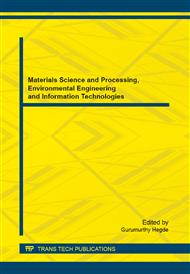p.355
p.359
p.363
p.367
p.371
p.375
p.379
p.383
p.388
Electrospinning of Poly(Lactic Acid)/Poly(Lactic Acid-Co-Lysine) Blend
Abstract:
Electrospun poly (lactic acid)/poly (lactic acid-co-lysine) (PLA/PLL) blend were prepared, and the structures including fibers, beads and microspheres and properties of electrospun material were characterized. Viscosity, conductivity and surface tension of electrospinning solution had critical effect on the structures of the electrospun blend. The optimization process conditions of PLA/PLL electrospun fibers, beads and microspheres were confirmed and the structures, thermal properties, crystal properties, and hydrophilicity were analyzed. The results showed that the average diameter of electrospun PLA/PLL fibers was less than that of PLA under the same spinning process, and the crystallinity of spun products was affected by solution concentration, pushing speed and spinning voltage. Accurate controlling of spinning product morphology can be achieved by adjusting the formulation of electrospinning solution and spinning process. The addition of PLL into PLA could improve the hydrophilicity of electrospun PLA/PLL products.
Info:
Periodical:
Pages:
371-374
Citation:
Online since:
October 2014
Authors:
Price:
Сopyright:
© 2014 Trans Tech Publications Ltd. All Rights Reserved
Share:
Citation:


